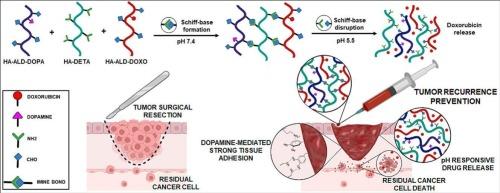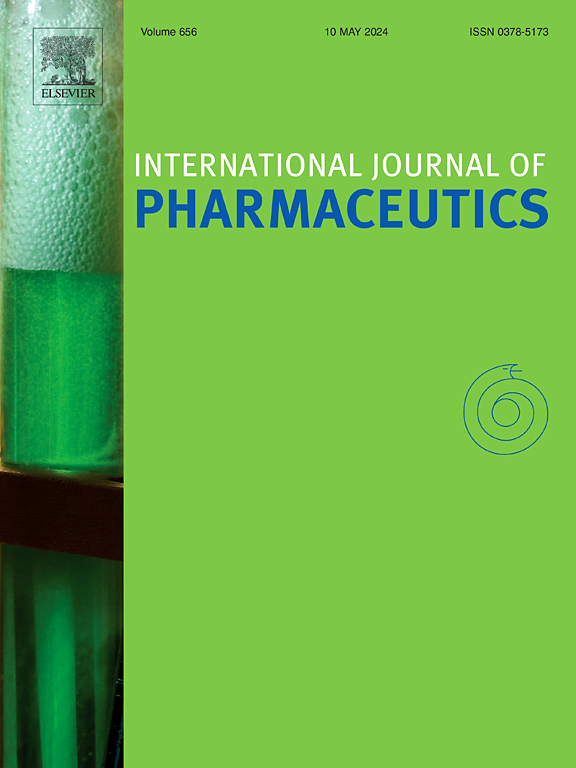可注射的、生物黏附的、ph响应的透明质酸水凝胶的开发和表征,用于增强术后癌症治疗。
IF 5.2
2区 医学
Q1 PHARMACOLOGY & PHARMACY
引用次数: 0
摘要
癌症复发仍然是术后治疗的主要挑战,通常是由于手术切除不完全和常规化疗的有效性有限。传统的给药系统显示出明显的局限性,特别是在确保持续的局部药物释放和对不规则组织表面的有效粘附方面。为了解决这些问题,本研究提出了一种局部癌症治疗的方法,该方法使用具有可注射性、生物粘附性、自愈性和对肿瘤微环境(TME)的反应性的原位形成水凝胶。水凝胶是基于透明质酸(HA)衍生物,功能化赋予不同的性质。透明质酸醛衍生物接枝多巴胺(HA-ALD-DOPA),具有生物粘附特性;确保水凝胶附着于术后部位并防止因生理运动而产生位移,以及负载抗癌药物阿霉素的HA醛衍生物(HA- ald - doxo)均与HA二乙烯三胺衍生物(HA- deta)交联,形成基于动态希夫碱的平台,有助于水凝胶的自我修复和ph敏感的药物释放行为。水凝胶表现出剪切减薄行为,在保持机械完整性的同时易于注射。体外药物释放研究证实了该系统的pH响应特性,在生理pH下控制释放,在酸性条件下快速释放,模拟TME。本文章由计算机程序翻译,如有差异,请以英文原文为准。

Development and characterization of injectable, bioadhesive, pH-responsive hyaluronic acid-based hydrogels for enhanced postoperative cancer therapy
Cancer recurrence remains a major challenge in postoperative treatment, often due to incomplete surgical resection and the limited effectiveness of conventional chemotherapy. Traditional drug delivery systems show significant limitations, particularly in ensuring sustained local drug release and effective adhesion to irregular tissue surfaces. To address these issues, this study presents an approach for localized cancer therapy using in situ-forming hydrogels that combine injectability, bioadhesion, self-healing properties, and responsiveness to the tumor microenvironment (TME).
The hydrogels are based on hyaluronic acid (HA) derivatives, functionalized to impart distinct properties. A hyaluronic acid aldehyde derivative grafted dopamine (HA-ALD-DOPA), which provides bioadhesive characteristics, ensuring the hydrogel’s attachment to postoperative sites and preventing displacement due to physiological movements and a HA aldehyde Doxorubicin derivative (HA-ALD-DOXO) loaded with the anticancer drug doxorubicin were both crosslinked with the HA diethylenetriamine derivative (HA-DETA) forming a dynamic Schiff base based platform that contribute to the hydrogel’s self-healing and pH-sensitive drug release behaviors. The hydrogels exhibited shear-thinning behavior for easy injectability while maintaining mechanical integrity. In vitro drug release studies confirmed the pH-responsive nature of the system, with controlled release at physiological pH and fast release under acidic conditions, simulating the TME.
求助全文
通过发布文献求助,成功后即可免费获取论文全文。
去求助
来源期刊
CiteScore
10.70
自引率
8.60%
发文量
951
审稿时长
72 days
期刊介绍:
The International Journal of Pharmaceutics is the third most cited journal in the "Pharmacy & Pharmacology" category out of 366 journals, being the true home for pharmaceutical scientists concerned with the physical, chemical and biological properties of devices and delivery systems for drugs, vaccines and biologicals, including their design, manufacture and evaluation. This includes evaluation of the properties of drugs, excipients such as surfactants and polymers and novel materials. The journal has special sections on pharmaceutical nanotechnology and personalized medicines, and publishes research papers, reviews, commentaries and letters to the editor as well as special issues.

 求助内容:
求助内容: 应助结果提醒方式:
应助结果提醒方式:


